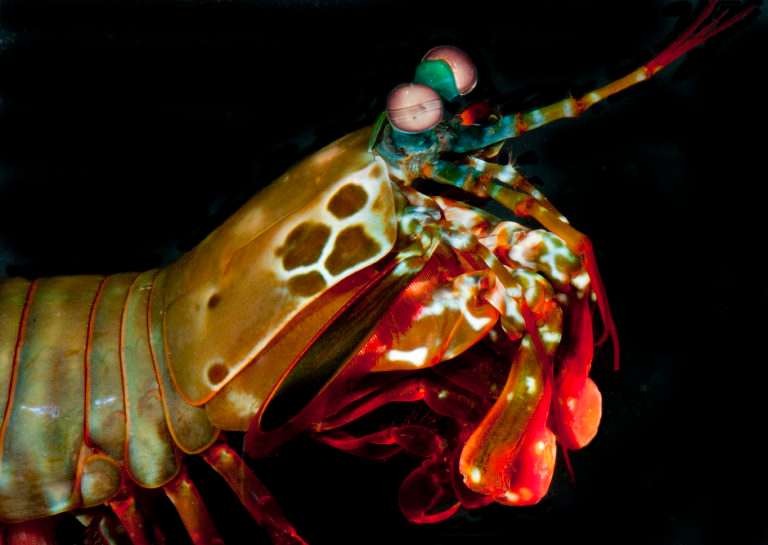Aug 18 2020
Materials scientists at the University of California, Irvine (UCI) have been gaining insights about resilience from the mantis shrimp.
 The mantis shrimp is armed with two appendages called dactyl clubs that can accelerate from the body at over 50 mph to bludgeon and smash prey—yet they appear undamaged afterward. “Think about punching a wall a couple thousand times at those speeds and not breaking your fist,” said David Kisailus, UCI professor of materials science and engineering. “That’s pretty impressive, and it got us thinking about how this could be.” Image Credit: Kisailus lab / UCI.
The mantis shrimp is armed with two appendages called dactyl clubs that can accelerate from the body at over 50 mph to bludgeon and smash prey—yet they appear undamaged afterward. “Think about punching a wall a couple thousand times at those speeds and not breaking your fist,” said David Kisailus, UCI professor of materials science and engineering. “That’s pretty impressive, and it got us thinking about how this could be.” Image Credit: Kisailus lab / UCI.
These ancient crustaceans are equipped with two hammer-like raptorial appendages known as dactyl clubs. They use these clubs to bludgeon and crush their prey. Such fists have the ability to quickly advance from the body at speeds of over 50 mph, delivering strong blows. Yet, they remain unbroken after the impact.
The UCI scientists have found out that the clubs contain a nanoparticle coating that absorbs and disperses the energy. The results were recently reported in the Nature Materials journal and could find considerable applications for engineered materials in the sports, aerospace, and automotive sectors.
Think about punching a wall a couple thousand times at those speeds and not breaking your fist. That’s pretty impressive, and it got us thinking about how this could be.
David Kisailus, Professor of Materials Science and Engineering, University of California, Irvine
Kisailus has been studying the mantis shrimp for more than 10 years.
Together with postdoctoral scholar Wei Huang, Kisailus employed transmission electron and atomic force microscopy to investigate the material components and nanoscale architecture of the surface layer of the clubs.
They found that the nanoparticles are bicontinuous spheres formed of intertwined inorganic (calcium phosphate) and organic (polysaccharide and protein) nanocrystals.
The 3D inorganic nanocrystals are mesocrystalline by nature, typically stacked together similarly to Lego pieces, where there are small differences in the orientation where they combine with each other. The crystalline interfaces are vital for the durability of the surface layer since they tend to fracture and break as a result of high-speed impact, which reduces the penetration depth by half.
The high-resolution TEM really helped us understand these particles, how they’re architected and how they react under different types of stress. At relatively low strain rates, the particles deform almost like a marshmallow and recover when the stress is relieved.
David Kisailus, Professor of Materials Science and Engineering, University of California, Irvine
Kisailus observed that the behavior of the structures under a high strain is very different. “The particles stiffen and fracture at the nanocrystalline interfaces,” Kisailus added. “When you break something, you’re opening up new surfaces that dissipate significant amounts of energy.”
The research group—including scientists from Purdue University, Oxford Instruments, and Bruker Corp.—quantified and described the magnificent damping abilities of the coating.
The stiff inorganic and soft organic materials in an interpenetrating network confer impressive damping properties to the coating without compromising stiffness. It’s a rare combination that outperforms most metals and technical ceramics.
David Kisailus, Professor of Materials Science and Engineering, University of California, Irvine
Kisailus further stated that he has been making efforts to translate the results of this study into new applications in various fields: “We can imagine ways to engineer similar particles to add enhanced protective surfaces for use in automobiles, aircraft, football helmets and body armor.”
This multi-institutional study was financially supported by the Air Force Office of Scientific Research.
Journal Reference
Huang, W., et al. (2020) A natural impact-resistant bicontinuous composite nanoparticle coating. Nature Materials. doi.org/10.1038/s41563-020-0768-7.
Source: https://uci.edu/